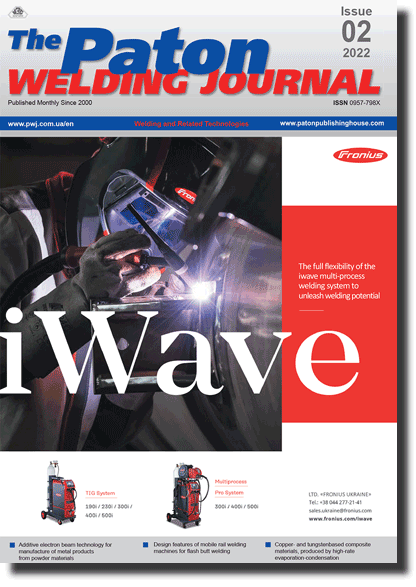| 2022 №02 (07) |
DOI of Article 10.37434/tpwj2022.02.08 |
2022 №02 (01) |

The Paton Welding Journal, 2022, #2, 48-53 pages
Calculated estimation of load-carrying capacity of the main span beams of the E.O. Paton bridge across the Dnipro in Kyiv by nondestructive testing results
O.O. Makhnenko, O.V. Makhnenko
E.O. Paton Electric Welding Institute of the NASU. 11 Kazymyr Malevych Str., 03150, Kyiv, Ukraine. E-mail: makhnenko@paton.kiev.ua
Abstract
The paper deals with of the features of the design and loading parameters of the main longitudinal beams of the E.O. Paton Bridge across the Dnipro. It is shown that by the results of examinations, the welded joints are in a satisfactory condition, no inadmissible defects or fatigue cracks were detected in them, but rather considerable local corrosion damage appeared as a result of water flowing through the beam structures. The constructed finite element model of the main span beam was used to perform a calculated estimation of its loading and of the change of load-carrying capacity in the presence of local corrosion defects in the zone of the web and lower flange joint. Results of numerical modeling showed that the presence of these defects does not cause any significant increase of stresses in the span beam. Analysis of load-carrying capacity revealed that although the welded structure of the main span beams of the bridge has a rather high static strength margin under the action of normative distributed loading, presence of local corrosion defects of material discontinuity of rather large size considerably lowers the fatigue resistance of welded joints with detected defects that is dangerous in terms of span structure reliability and, therefore, requires immediate performance of repair operations.
Keywords: bridge welded structure, main span beam, load-carrying capacity, corrosion defect, normative load, stressed state, numerical methods
Received: 11.10.2021
Accepted: 31.03.2022
References
1. Lobanov, L.M., Kyrian, V.I. (2013) The E.O. Paton all-welded bridge is sixty years old. The Paton Welding J., 12, 33–38.2. Poznyakov, V.D., Dyadin, V.P., Davydov, Ye.O., Dmytrienko, R.I. (2021) Evaluation of damage of all-welded longitudinal main beams of the E.O. Paton bridge across the Dnipro river. Ibid., 7, 33-41. https://doi.org/10.37434/as2021.07.06
3. (2009) DBN V. 2.3-22:201Kh: Bridges and pipes. Basic design requirements. Kyiv, Ministry of Regional Development of Construction, Housing and Communal Services of Ukraine [in Ukrainian].
4. (2009) DBN V.1.2-15:2009: Bridges and pipes. Loading and effects. Kyiv, Minregionbud Ukrainy [in Ukrainian].
5. (1996) Recommendations for Fatigue Design of Welded Joints and Components. IIW Doc. XIII-1539‒96/XV-845‒96.
6. Berthellemy, J. (2015) Maintenance of road bridges and road equipments optimized by a good fatigue design. Procedia Engineering, 133, 255‒264. DOI: 10.1016/j.proeng.2015.12.666.
7. (2005) EN 1993-1-9: Eurocode 3: Design of steel structures. Pt 1‒9: Fatigue.
Suggested Citation
O.O. Makhnenko, O.V. Makhnenko (2022) Calculated estimation of load-carrying capacity of the main span beams of the E.O. Paton bridge across the Dnipro in Kyiv by nondestructive testing results. The Paton Welding J., 02, 48-53.The cost of subscription/purchase order journals or individual articles
| Journal/Currency | Annual Set | 1 issue printed |
1 issue |
one article |
| TPWJ/USD | 384 $ | 32 $ | 26 $ | 13 $ |
| TPWJ/EUR | 348 € | 29 € | 24 € | 12 € |
| TPWJ/UAH | 7200 UAH | 600 UAH | 600 UAH | 280 UAH |
| AS/UAH | 1800 UAH | 300 UAH | 300 UAH | 150 UAH |
| AS/USD | 192 $ | 32 $ | 26 $ | 13 $ |
| AS/EUR | 180 € | 30 € | 25 € | 12 € |
| SEM/UAH | 1200 UAH | 300 UAH | 300 UAH | 150 UAH |
| SEM/USD | 128 $ | 32 $ | 26 $ | 13 $ |
| SEM/EUR | 120 € | 30 € | 25 € | 12 € |
| TDNK/UAH | 1200 UAH | 300 UAH | 300 UAH | 150 UAH |
| TDNK/USD | 128 $ | 32 $ | 26 $ | 13 $ |
| TDNK/EUR | 120 € | 30 € | 25 € | 15 € |
AS = «Automatic Welding» - 6 issues per year;
TPWJ = «PATON WELDING JOURNAL» - 12 issues per year;
SEM = «Electrometallurgy Today» - 4 issues per year;
TDNK = «Technical Diagnostics and Non-Destructive Testing» - 4 issues per year.


